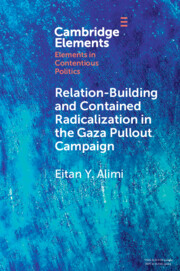Refine search
Actions for selected content:
47 results

The Cambridge Handbook of the Psychology of Violent Extremism
-
- Published online:
- 31 October 2025
- Print publication:
- 07 August 2025
14 - Political Violence and Terrorism
- from Part II - The Traditional Security Agenda
-
- Book:
- Understanding International Security
- Published online:
- 11 October 2025
- Print publication:
- 30 October 2025, pp 280-300
-
- Chapter
- Export citation
16 - The Role of Relative Deprivation in the Process of Radicalization into Violent Extremism
- from Part III - Group-Level Perspectives
-
-
- Book:
- The Cambridge Handbook of the Psychology of Violent Extremism
- Published online:
- 31 October 2025
- Print publication:
- 07 August 2025, pp 323-344
-
- Chapter
- Export citation
11 - Emotions in Violent Extremism
- from Part II - Individual-Level Perspectives
-
-
- Book:
- The Cambridge Handbook of the Psychology of Violent Extremism
- Published online:
- 31 October 2025
- Print publication:
- 07 August 2025, pp 207-230
-
- Chapter
- Export citation
9 - Conspiracy Theories and Violent Extremism
- from Part II - Individual-Level Perspectives
-
-
- Book:
- The Cambridge Handbook of the Psychology of Violent Extremism
- Published online:
- 31 October 2025
- Print publication:
- 07 August 2025, pp 166-184
-
- Chapter
- Export citation
17 - Navigating the Threat Landscape
- from Part III - Group-Level Perspectives
-
-
- Book:
- The Cambridge Handbook of the Psychology of Violent Extremism
- Published online:
- 31 October 2025
- Print publication:
- 07 August 2025, pp 345-365
-
- Chapter
- Export citation
20 - Foreign Military Interventions, Occupations, and Violent Extremism
- from Part IV - Macro-Level Perspectives
-
-
- Book:
- The Cambridge Handbook of the Psychology of Violent Extremism
- Published online:
- 31 October 2025
- Print publication:
- 07 August 2025, pp 410-425
-
- Chapter
- Export citation
12 - Social Identity, Self-Uncertainty, and Violent Extremism
- from Part III - Group-Level Perspectives
-
-
- Book:
- The Cambridge Handbook of the Psychology of Violent Extremism
- Published online:
- 31 October 2025
- Print publication:
- 07 August 2025, pp 233-253
-
- Chapter
- Export citation
8 - Religious Fundamentalism and Violent Extremism
- from Part II - Individual-Level Perspectives
-
-
- Book:
- The Cambridge Handbook of the Psychology of Violent Extremism
- Published online:
- 31 October 2025
- Print publication:
- 07 August 2025, pp 142-165
-
- Chapter
- Export citation
19 - Inequality, Poverty, and the Staircase to Terrorism
- from Part IV - Macro-Level Perspectives
-
-
- Book:
- The Cambridge Handbook of the Psychology of Violent Extremism
- Published online:
- 31 October 2025
- Print publication:
- 07 August 2025, pp 389-409
-
- Chapter
- Export citation
6 - The Role of Gender in Violent Extremism
- from Part II - Individual-Level Perspectives
-
-
- Book:
- The Cambridge Handbook of the Psychology of Violent Extremism
- Published online:
- 31 October 2025
- Print publication:
- 07 August 2025, pp 100-118
-
- Chapter
- Export citation
2 - Terrorism, Radicalization, and (Violent) Extremism
- from Part I - Concepts, Definitions, and Trends
-
-
- Book:
- The Cambridge Handbook of the Psychology of Violent Extremism
- Published online:
- 31 October 2025
- Print publication:
- 07 August 2025, pp 11-27
-
- Chapter
- Export citation
5 - Conceptualizing Diversity among Violent Extremists
- from Part II - Individual-Level Perspectives
-
-
- Book:
- The Cambridge Handbook of the Psychology of Violent Extremism
- Published online:
- 31 October 2025
- Print publication:
- 07 August 2025, pp 78-99
-
- Chapter
- Export citation
Chapter 13 - Treatment
- from Section 3 - Treatment and Legal Repercussions
-
-
- Book:
- A Clinical and Forensic Guide to Cults and Persuasive Leadership
- Published online:
- 19 June 2025
- Print publication:
- 03 July 2025, pp 251-272
-
- Chapter
- Export citation
6 - The Wehrmacht, Its Allies, and “Partisan Threats”
- from Part I - Structures, Players, and Processes
-
-
- Book:
- The Cambridge History of the Holocaust
- Published online:
- 21 May 2025
- Print publication:
- 12 June 2025, pp 146-168
-
- Chapter
- Export citation
Introduction to Volume II
-
-
- Book:
- The Cambridge History of the Holocaust
- Published online:
- 21 May 2025
- Print publication:
- 12 June 2025, pp 8-24
-
- Chapter
- Export citation
Conclusions
- from Part II - A New Right? Ideational and Programmatic Change after the Left Turn
-
-
- Book:
- The Recasting of the Latin American Right
- Published online:
- 29 November 2024
- Print publication:
- 12 December 2024, pp 237-246
-
- Chapter
- Export citation

Relation-Building and Contained Radicalization in the Gaza Pullout Campaign
-
- Published online:
- 03 December 2024
- Print publication:
- 27 February 2025
-
- Element
- Export citation
10 - Religious Extremism
- from Part Five - The Effects of Religion
-
- Book:
- The Psychology of Religion
- Published online:
- 01 November 2024
- Print publication:
- 31 October 2024, pp 415-464
-
- Chapter
- Export citation
2 - Exclusion and Radicalization
- from Part I - The Link between Exclusion and Extremism
-
-
- Book:
- Exclusion and Extremism
- Published online:
- 16 May 2024
- Print publication:
- 23 May 2024, pp 27-50
-
- Chapter
- Export citation
